
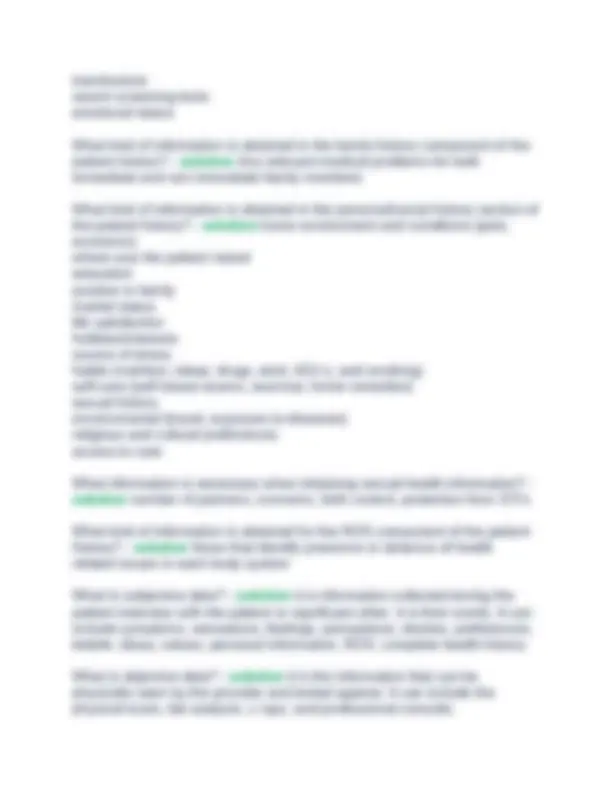




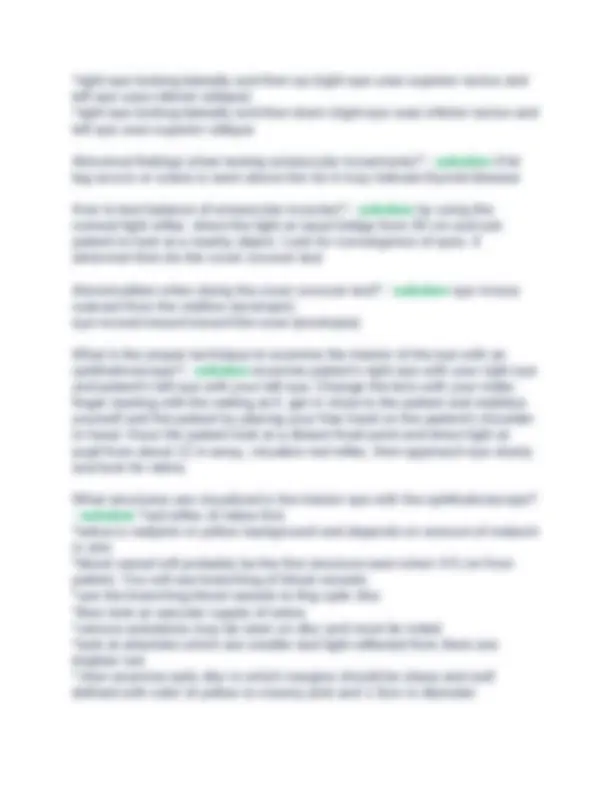
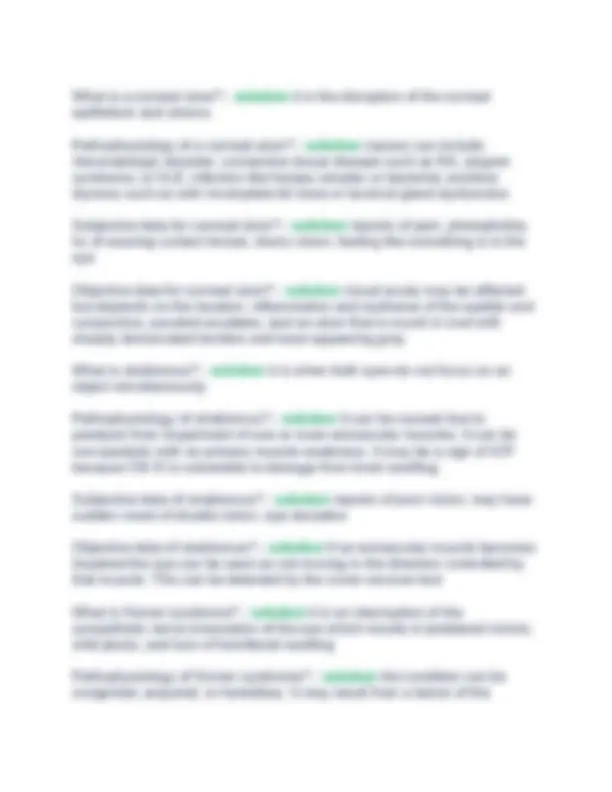
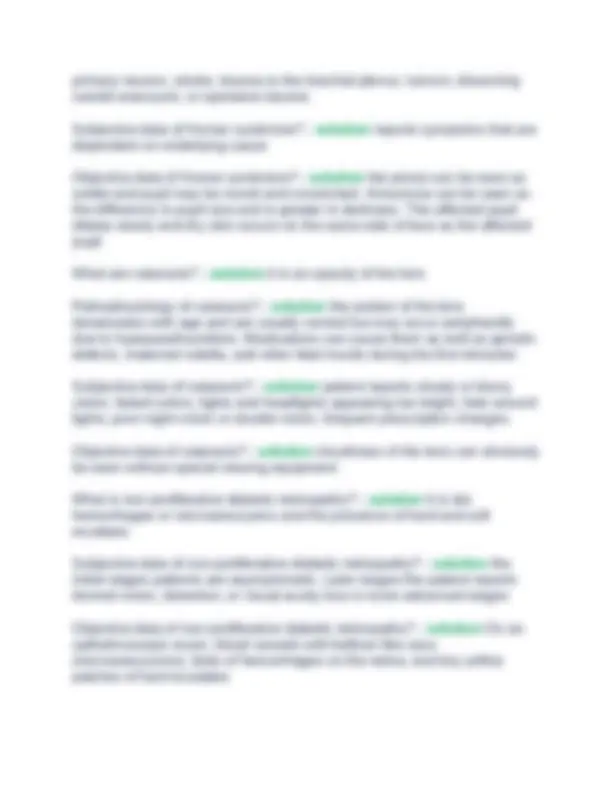




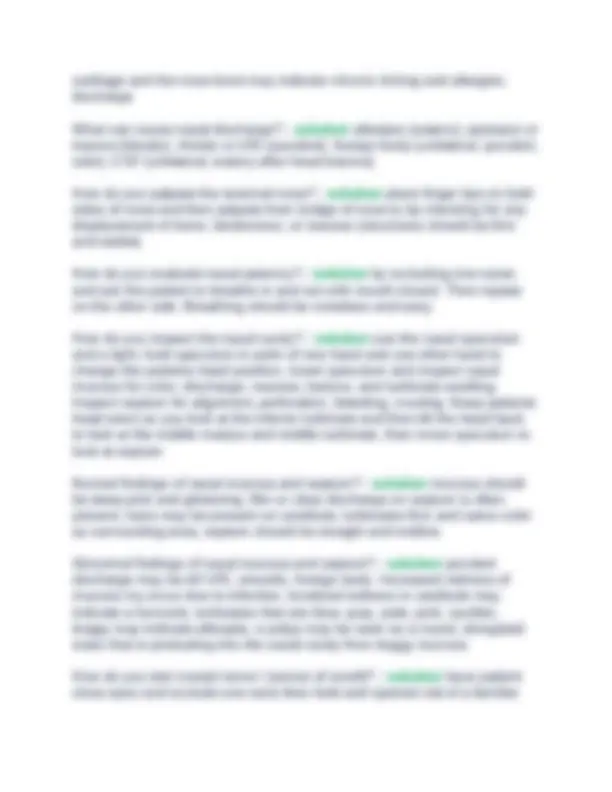

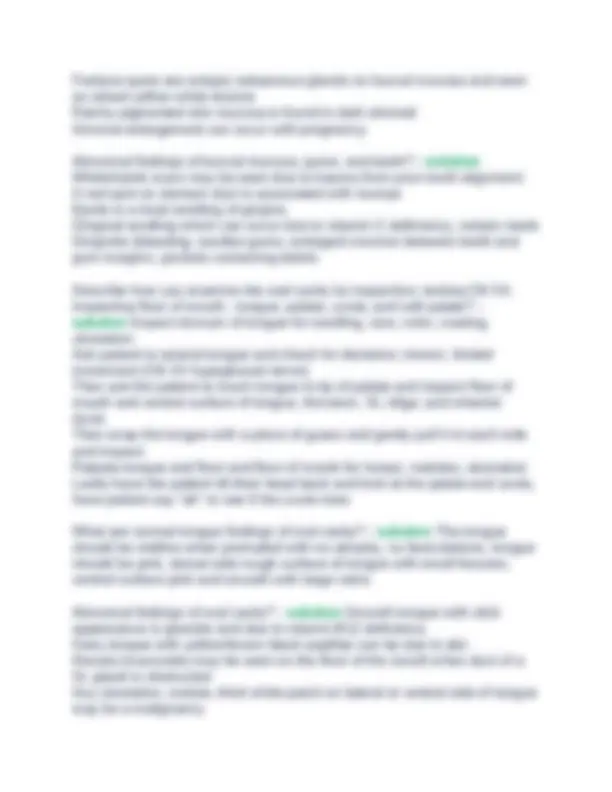

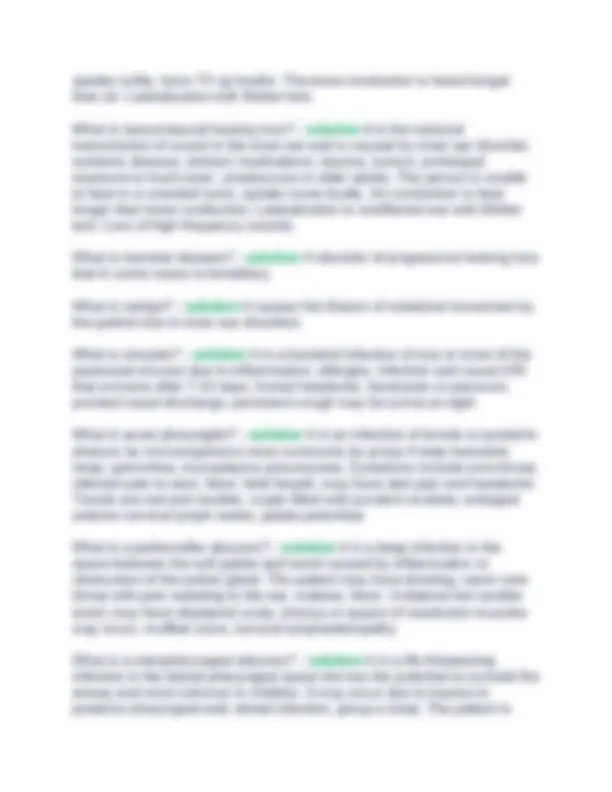
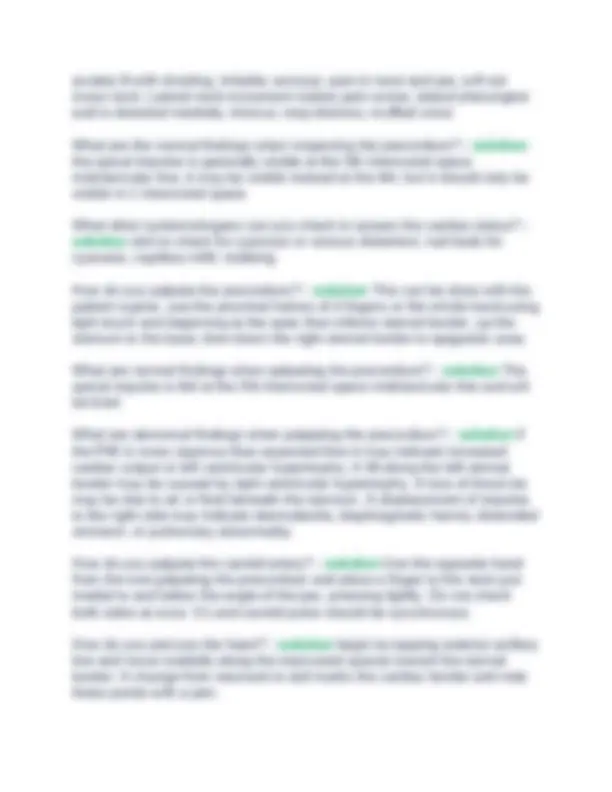
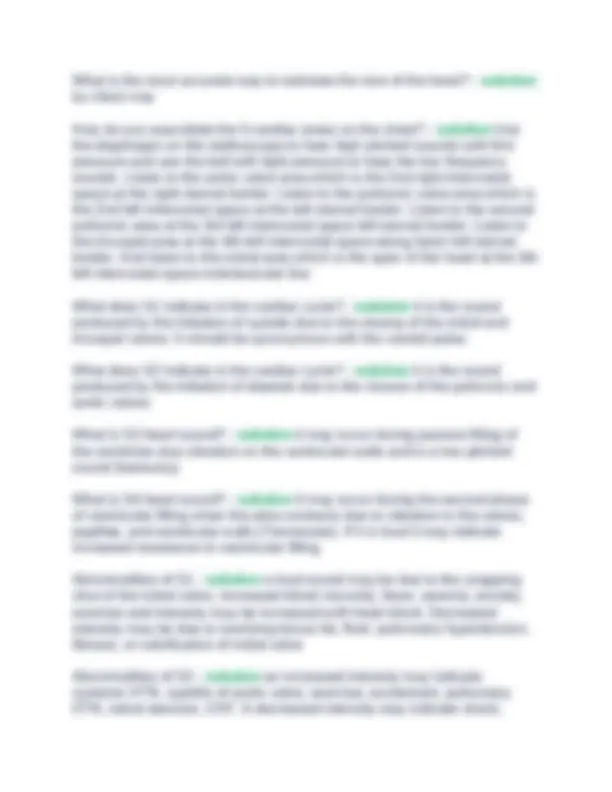



Study with the several resources on Docsity

Earn points by helping other students or get them with a premium plan


Prepare for your exams
Study with the several resources on Docsity

Earn points to download
Earn points by helping other students or get them with a premium plan
Community
Ask the community for help and clear up your study doubts
Discover the best universities in your country according to Docsity users
Free resources
Download our free guides on studying techniques, anxiety management strategies, and thesis advice from Docsity tutors
Advanced health assessment exam 1 Questions with 100% solutions 2024 EXAM SOLUTION GRADED A+
Typology: Exams
1 / 28

This page cannot be seen from the preview
Don't miss anything!





















What are the concepts of developing a relationship with the patient? - solution See the patient as a unique individual Let them know that you really want to know all that is needed Be open and flexible Explain boundaries Be honest What is the primary objective when developing a relationship with the patient? - solution To discover the details about a patient's concern, explore expectations, display interest, and partnership What does establishing a positive relationship with the patient depend on? - solution Communication built on courtesy, comfort, connection, and confirmation. What are effective communication strategies when obtaining a health history? - solution Using open-ended questions, direct questions, rarely leading questions. Facilitate by encouraging patient to say more. Reflect by repeating what you heard. Clarify. Empathize by showing understanding and acceptance. Confront by discussing disturbing behavior. Interpret by repeating what you heard to confirm. What are open-ended questions? - solution Those that give the patient discretion about the extent of the answer. Such as "How have you been feeling?" or "What brings you in today?" What are direct questions? - solution Those that seek specific information. Such as "How long ago did that happen?" or "Where does it hurt?" What are leading questions? - solution Those that are prompting the patient toward the desired answer and these are the most risky.
What is a patient centered question? - solution One that respects and responds to a patient's wants, needs, preferences so that they can make choices in their care that best fit their individual circumstances. Such as "How would you like to be addressed?", "What would you like us to do today?", "How are you coping with your illness?". What are potential barriers of patient and provider communication? - solution When the patient is curious about you, anxiety, silence, depression, crying/compassionate moments, physical & emotional intimacy, seduction, anger, avoiding the full story, financial considerations. What is the structure and components of the patient history? - solution Patient identifiers, chief complaint, history of present illness, past medical history, family history, personal/social history, review of systems What kind of patient information is obtained in the patient identifier component of the patient history? - solution name, age, gender, race, occupation, date, time, and referral source What kind of patient information is obtained in the chief complaint component of the patient history? - solution a brief statement about why the patient is seeking care while probing for underlying concerns. What kind of patient information is obtained in the HPI component of the patient history? - solution a chronological order of events leading up to the presenting problem, health status prior to the onset, a complete description of first symptoms, symptom analysis (onset, location, description, duration, intensity, character, aggravating factors, alleviating factors), impact on patients lifestyle, medications or treatments tried What kind of information is obtained in the PMH component of the patient history? - solution general health/strength childhood illnesses major adult illnesses and chronic diseases immunization surgeries (dates, hospital, diagnosis, complications) serious injuries resulting in disability limitation of ability to function d/t past events medications allergies (meds, environment, seasonal, food)
How do you approach sensitive issues when interviewing a patient? - solution Provide privacy, be direct and firm, don't ask leading questions, use open-ended questions, don't apologize for asking questions, don't preach, avoid confrontation, use understandable language, watch medical jargon, document carefully using the patient's words. What does it mean to be culturally aware? - solution It is the deliberate self-examination and in depth exploration of one's own biases, stereotypes, prejudices, assumptions that one holds about people different than them. What does it mean to be culturally competent? - solution It requires the provider to be sensitive to a patient's heritage, sexual orientation, socioeconomic situation, ethnicity, and cultural background What are examples of questions that explore the patient's culture? - solution "what do you call your problem?" "What do you think caused it?" "What does your sickness do to you?" "Why do you think it started when it did?" "What should be done to get rid of it?" "Who else or what else might help you get better?" What are the components of a cultural response to a patient? - solution the response should include modes of communication to include speech, space, and body language, awareness of the the patients health beliefs, diet and nutritional practice, and the nature of relationships with their family How do you measure visual acuity and test CN II - solution by measuring distance, near vision , and peripheral vision What is CN II? - solution optic nerve How do you measure distance vision for visual acuity? - solution by using a snellen chart and having the patient cover one eye and read the lowest line that he can see clearly and then alternate eyes How do you document distance vision? - solution the numerator is 20 and the denominator is the distance at which the average eye can read the line.
How do you measure near vision? - solution by using a rosenbaum pocket screener and have the patient hold it about 14 inches from eyes and read the smallest line possible with one eye and then the other How do you measure peripheral vision? - solution by using the confrontation test. Have the patient sit directly across from you and look directly at you. Have them cover their left eye and your cover your right eye. Then test nasal, temporal, superior, and inferior fields. Have the patient tell you as soon as they see your finger in each of those fields. What may be some causes of abnormal results from the confrontation test?
If the patient complains of pain when you palpate the orbit what can be the cause? - solution scleritis, orbital cellulitis, cavernous sinus thrombosis If the eye is very firm or resists palpation what does this indicate? - solution it can be a sign of severe glaucoma or retrobulbar tumor How do you inspect the lower conjunctiva? - solution have the patient look up while you draw the lower eyelid down and note the translucency and vascular pattern, erythema, exudate How do you inspect the upper conjunctiva? - solution this is only done when there is a foreign object present. Evert the upper lid one a cotton swab What can cause erythema or cobblestone appearance to conjunctiva? - solution allergic or infections conjunctivitis What is a subconjunctival hemorrhage? - solution it is seen as bright red blood in a sharply defined area that is surrounded by healthy conjunctiva which may occur spontaneously in pregnancy or labor What is a pterygium? - solution it is the abnormal growth of conjunctiva tissue over the cornea and more common on the nasal side. This is more common in persons exposed to UV light. How do you examine the cornea for clarity? - solution check for clarity by shining a light tangentially on it. blood vessels should not be present What is corneal arcus? - solution it is lipid deposits in the periphery of the cornea and common after age 60. If they present in persons less than 40 it may indicate a lipid disorder How do you check corneal sensitivity (CN V) - solution by touching a cotton wisp to the cornea which should make the patient blink. This indicates an intact CN V and motor fibers of CN VII (facial nerve) What is CN IV? - solution trochlear nerve
What is decreased corneal sensitivity caused by? - solution diabetes, herpes simplex, herpes zoster, after trigeminal neuralgia surgery How do you inspect the iris? - solution check it for visibility and uniform color How do you inspect the pupil? - solution note irregularities in shape of pupil, they should be round, regular, and equal in size How do you test the pupil? - solution check the pupils response to light and accomodation How do you test pupil accommodation? - solution have the patient look at a distant object and then a test object held 10 cm from bridge of nose. Expect the pupils to constrict when eyes focus on the near object If pupils fail to respond to light but retains constriction during accommodation, what can be the cause? - solution sometimes seen with diabetes or syphilis What is miosis? - solution it is pupil constriction of less than 2 mm with causes of miotic eyedrop use, drug abuse What is mydriasis? - solution it is pupil dilation of more than 6 mm with causes including mydriatic drops, midbrain lesions, hypoxia, CN III damage, drug abuse, acute angle glaucoma What is argyll robertson pupil? - solution it is a bilateral, miotic, irregular shaped pupils that fail to constrict to light and caused by syphilis, DM, midbrain lesions What is anisocoria? - solution unequal pupil sizes which may be normal in about 20% of the population What is iritis? - solution constrictive response, acute uveitis with pain and red eye What can occur to pupils with damage to CN III (oculomotor) - solution pupil dilated and fixed with eye deviated lateral and down with ptosis
*right eye looking laterally and then up (right eye uses superior rectus and left eye uses inferior oblique) *right eye looking laterally and then down (right eye uses inferior rectus and left eye uses superior oblique Abnormal findings when testing extraocular movements? - solution if lid lag occurs or sclera is seen above the iris it may indicate thyroid disease How to test balance of extraocular muscles? - solution by using the corneal light reflex. direct the light at nasal bridge from 30 cm and ask patient to look at a nearby object. Look for convergence of eyes. if abnormal then do the cover uncover test Abnormalities when doing the cover uncover test? - solution eye moves outward from the midline (exotropic) eye moved inward toward the nose (esotropia) What is the proper technique to examine the interior of the eye with an ophthalmoscope? - solution examine patient's right eye with your right eye and patient's left eye with your left eye. Change the lens with your index finger starting with the setting at 0. get in close to the patient and stabilize yourself and the patient by placing your free hand on the patient's shoulder or head. Have the patient look at a distant fixed point and direct light at pupil from about 12 in away, visualize red reflex, then approach eye slowly and look for retina. What structures are visualized in the interior eye with the ophthalmoscope?
then examine macula by asking patient to look directly at the light and it will appear as a lighter dot surrounded by an avascular area What may vessels look like with someone who has HTN? - solution they may be narrowing, increased vascular tortuosity, copper wiring (diffuse red brown reflex), retinal hemorrhage, arteriovenous nicking How is a lesion expressed? - solution for example, being 2 DD from optic disc at the 2 o clock position and is 2/3 DD long and 1/3 DD wide What do myelinated nerve fibers look like in the eye? - solution they appear as white area with soft, ill defined peripheral margins and have no significance What is papilledema? - solution it is the loss of definition of the optic disc margin, vessels are pushed forward and veins dilate. Caused by increased ICP What is glaucomatous optic head cupping? - solution optic disc margins are raised with lower central area , blood vessels may disappear. Caused by increased intraocular pressure with loss of nerve fibers and death of ganglion cells What is a cotton wool spot? - solution they are ill defined yellow areas that are caused by infarction of nerve layer of the retina and due to HTN and diabetes What are drusen bodies? - solution they are small, discrete spots that are slightly more yellow than the retina and most commonly a consequence of aging and may be a precursor to macular degeneration. *use Amsler grid to determine macular degeneration what is exophthalmos? - solution it is the bulging of the eye anteriorly out of the orbit What is the pathophysiology of exophthalmos? - solution occurs from an increase in volume of orbital contents. It is most cause is graves disease due to abnormal connective tissue deposits in the orbit and extraocular muscles. It can be bilateral or unilateral. If unilateral then consider a retro- orbital tumor
What is a corneal ulcer? - solution it is the disruption of the corneal epithelium and stroma Pathophysiology of a corneal ulcer? - solution causes can include rheumatologic disorder, connective tissue disease such as RA, sjogren syndrome, or SLE, infection like herpes simplex or bacterial, extreme dryness such as with incomplete lid close or lacrimal gland dysfunction Subjective data for corneal ulcer? - solution reports of pain, photophobia, hx of wearing contact lenses, blurry vision, feeling like something is in the eye Objective data for corneal ulcer? - solution visual acuity may be affected but depends on the location, inflammation and erythema of the eyelids and conjunctiva, purulent exudates, and an ulcer that is round or oval with sharply demarcated borders and base appearing gray What is strabismus? - solution it is when both eyes do not focus on an object simultaneously Pathophysiology of strabismus? - solution it can be caused due to paralysis from impairment of one or more extraocular muscles. It can be non-paralytic with no primary muscle weakness. It may be a sign of ICP because CN III is vulnerable to damage from brain swelling. Subjective data of strabismus? - solution reports of poor vision, may have sudden onset of double vision, eye deviation Objective data of strabismus? - solution If an extraocular muscle becomes impaired the eye can be seen as not moving in the direction controlled by that muscle. This can be detected by the cover-uncover test What is Horner syndrome? - solution it is an interruption of the sympathetic nerve innervation of the eye which results in ipsilateral miosis, mild ptosis, and loss of hemifacial swelling Pathophysiology of Horner syndrome? - solution the condition can be congenital, acquired, or hereditary. It may result from a lesion of the
primary neuron, stroke, trauma to the brachial plexus, tumors, dissecting carotid aneurysm, or operative trauma. Subjective data of Horner syndrome? - solution reports symptoms that are dependent on underlying cause Objective data of Horner syndrome? - solution the ptosis can be seen as subtle and pupil may be round and constricted. Anisorocia can be seen as the difference in pupil size and is greater in darkness. The affected pupil dilates slowly and dry skin occurs on the same side of face as the affected pupil What are cataracts? - solution it is an opacity of the lens Pathophsyiology of cataracts? - solution the protien of the lens denaturates with age and are usually central but may occur peripherally due to hypoparathyroidism. Medications can cause them as well as genetic defects, maternal rubella, and other fetal insults during the first trimester Subjective data of cataracts? - solution patient reports cloudy or blurry vision, faded colors, lights and headlights appearing too bright, halo around lights, poor night vision or double vision, frequent prescription changes. Objective data of cataracts? - solution cloudiness of the lens can obviously be seen without special viewing equipment What is non-proliferative diabetic retinopathy? - solution it is dot hemorrhages or microaneurysms and the presence of hard and soft exudates Subjective data of non-proliferative diabetic retinopathy? - solution the initial stages patients are asymptomatic. Later stages the patient reports blurred vision, distortion, or visual acuity loss in more advanced stages Objective data of non-proliferative diabetic retinopathy? - solution On an opthalmoscopic exam, blood vessels with balloon-like sacs (microaneurysms), blots of hemorrhages on the retina, and tiny yellow patches of hard exudates
muscles, dysphagia, ataxia, intellectual delay, peripheral neuropathy, acanthotic (spiked) RBC's, absence of VLDL Subjective data of retinitis pigmentosa? - solution reports of night blindness as the earliest symptom, tunnel vision, bumping into furniture, loss of vision is painless and progressive over years to decades Objective data of retinitis pigmentosa? - solution the exam is normal in the early stages. In later stages waxy pallor, narrowing of the arterioles, and peripheral bone spicule pigmentation are seen in the mid periphery with retinal atrophy What is glaucoma? - solution it is a disease of the optic nerve where the nerve cells die, usually due to excessively high intraocular pressure Pathophysiology of glaucoma? - solution acute angle may occur acutely with dramatically elevated intraocular pressure if the iris blocks the exit of aqueous humor from the anterior chamber. Open angle is caused by decreasing aqueous humor absorption that leads to increased resistance and painless build up of pressure in the eye. This may also be congenital as a result of improper development of the eye's aqueous outflow system. Subjective data of glaucoma? - solution with chronic disease the symptoms may be asymptomatic with the exception of a gradual loss of peripheral vision over a period of years. an acute onset is accompanied by intense ocular pain, blurred vision, halos around lights, red eye, and a dilated pupil. Patients may also report stomach pain and N/V Objective data of glaucoma? - solution optic nerve damage can be seen clearly during a dilated eye exam and produces a characteristic appearance of the optic nerve cupping. Visual field tests may be decreased What is chorioretinitis? - solution it is an inflammatory process involving both the choroid and retina Pathophysiology of chorioretinitis? - solution the most common cause is laser therapy for diabetic retinopathy but may also be seen with histoplasmosis, CMV, toxoplasmosis, or congenital rubella infection
Subjective data of chorioretinitis? - solution reports of a history of cleaning cat litter box, laser surgery, pain, reduced visual acuity, floaters, photophobia. Objective data of chorioretinitis? - solution a sharply defined lesion that is generally whitish yellow and becomes stippled with dark pigment in later stages ending with a chorioretinal scar. Visual field defects can be detected with large lesion, may be single or multiple, feathery margins contrast with myelinated retinal fibers. What are visual field defects? - solution it is defective vision or blindness Pathophysiology of visual field defects? - solution it may be a consequence of degenerative changes within the eye such as a cataract or from a lesion of the optic nerve. The most common cause is interruption of the vascular supply to the optic nerve. Bitemporal hemianopia is caused by a lesion most commonly a pituitary tumor and homonymous hemianopia can be caused by lesions of the optic nerve radiation on either side of the brain occurring after the optic chiasm. Subjective data of visual field defects? - solution reports of defective vision or blindness Objective data of visual field defects? - solution visual field defects found on exam What is a retinoblastoma? - solution it is an embryonic malignant tumor arising from the retina Pathophysiology of retinoblastoma? - solution it usually develops in the first 2 years of life and is transmitted by autosomal dominant or a chromosomal mutation and is the most common retinal tumor in children Subjective data of retinoblastoma? - solution family history of it and reports of a white reflex on photographs Objective data of retinoblastoma? - solution the initial sign that can be seen is leukocoria, and then an ill defined mass arising from the retina on fundoscopic exam and chalky white areas of calcification can be seen
What are abnormal findings while inspecting the auricles? - solution blue color may mean cyanosis, pallor or extreme redness may result from vasomotor instability, frostbite can cause extreme pallor, unusual size or shape may be d/t family trait or abnormality, cauliflower ear is d/t blunt trauma with necrosis of underlying cartilage, tophi are small white uric acid crystals on peripheral margins of auricle and may indicate gout, sebaceous cysts How do you inspect the auditory canal? - solution visually inspect it for any discharge and note any odor What are some abnormal findings while inspecting the auditory canal? - solution purulent foul smelling discharge is associated with otitis externa, perforated acute otitis media, or foreign bodies. Bloody or serous discharge with a head trauma is indicative of a head fracture Describe palpating the auricles and mastoid area? - solution palpate both of them for any tenderness, swelling, or nodules What are normal findings when palpating the auricles and mastoid area? - solution auricles should be firm, mobile and without nodules. If folded forward it should readily recoil to its usual position. Pulling on the lobule should not illicit pain. What are abnormal findings when palpating the auricles and mastoid area?
Insert the speculum 1/2 inch and inspect from meatus to tympanic membrane (landmarks, color, contour, perforations How do you evaluate the patients hearing using a whispered voice? - solution Have the patient put a finger is one ear while you stand about 1- feet away from the opposite ear out of the line of vision from the patient. Then whisper a combination of letter and numbers into the ear and ask them to repeat it. They should be able to repeat 50% of the sounds. How do you perform the Weber test? - solution This is done to assess for unilateral hearing loss. Place the base of a vibrating tuning ford on the midline of the patients head and ask them if the sound is heard equally in both ears or just one. Abnormal findings of Weber test? - solution if the sound is better in the affected ear then the patient has conductive hearing loss. If the sound lateralizes to the better ear then it is sensorineural loss. How do you perform the Rinne test? - solution This is done to distinguish between air and bone hearing conduction. First place the base of a tuning fork against the patients mastoid bone and ask them to say when the sound is no longer heard. The time in seconds is the interval of bone conduction. Then quickly move the tuning fork 1/2 inch from the auditory canal and ask them again to say when it is no longer heard. The time in seconds is the air conduction interval. Normal should be longer hearing for air conduction (2:1). What are abnormal findings of the Rinne test? - solution if bone conduction is heard fro longer in the affected ear then it is a conductive loss. if the air conduction is heard longer but less than the 2:1 ratio then it a sensorineural loss How do you inspect the external nose? - solution Look for any deviations in shape, size, or color, discharge, flaring or narrowing or nares. Columnella should be midline and width should not exceed the diameter of the nares. Abnormal findings of external nose exam? - solution a depression of the nasal bridge can result from a fracture of nasal bone or previous nasal cartilage inflammation , a transverse crease at the junction between the